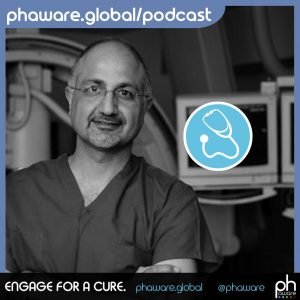Phaware Podcast: Roham Zamanian, MD, Part 2

This podcast series, created and produced by phaware, is being offered as a regular guest feature on Pulmonary Hypertension News to bring the voices and life experiences of PH patients, family members, caregivers, healthcare specialists, and others to our readers. You may listen to the podcast directly, or read it via the transcript that runs below.
I’m Aware That I’m Rare: Roham Zamanian, MD
The phaware interview (Part 2 of 2)
Dr. Roham Zamanian is the director of the Adult Pulmonary Hypertension (PH) Program at Stanford University Medical Center. In Part 2 of his two-episode series, Zamanian discusses the process of enrolling in clinical trials. He currently directs the Vera Moulton Wall Center clinical database and biobank.
His research is focused on the clinical characterization and impact of novel risk factors such as methamphetamine use, and biomarkers such as insulin resistance, in pulmonary arterial hypertension. Beyond industry clinical trials and registries, Zamanian has re-focused the research mission of the Stanford PH program by collaborating with basic science faculty and implementing several proof-of-concept and Phase 2 clinical trials of new therapies developed at Stanford University. He also serves on phaware’s Medical Advisory Board.
I’m Roham Zamanian. I’m the medical director of the Pulmonary Vascular Disease Program at Stanford University Medical Center.
Today we’ll talk about the process of enrolling and being a participant in a clinical trial.
I don’t know why, but for me, I have this association with Major Tom [“Space Oddity” by David Bowie], the song, about this astronaut going off into space and there is some, you know, complexity of this guy undergoing something that has either never been done before or is experimental or whatever, but for the sake of humanity.
is some, you know, complexity of this guy undergoing something that has either never been done before or is experimental or whatever, but for the sake of humanity.
I think [of] that when I have that conversation with patients, when I say, think of the generations beyond you. Think of the legacy that you set for people who are going to be diagnosed with this disease 10 or 20 years down the line, I think that’s powerful to people to realize that their involvement in a clinical trial, especially in a rare disease, will have impact on future generations. I think that that sort of empowers them to some extent.
If there is any expectation beyond good caring for themselves that I have of my patients is that the recognition that they can actually pay it forward to the future generations. I feel like every patient feels hopeless sometimes when they get this diagnosis and with pulmonary hypertension, for example, it’s a terrible disease. The conversation that I’ve had with my patients about empowering them to give to future generations — they quite like that.
Every clinical trial is based on data from basic or basic translation or even other clinical trials. Often people suspect we’re talking about medical therapy clinical trials, but it could also be procedures. The investigators who participate in recruiting patients for a clinical trial, they may or may not be the same investigators who’ve written up the protocol, but they’re mandated by the protocol of the clinical trial to take into account patients that would be ideal for this clinical trial and patients that would have characteristics that would be either harmful for them to be in the clinical trial or have some confounding issue with if they were to participate in the clinical trial.
The inclusion criteria guides the investigators on who would be part of a study. If I wanted to study a stem cell approach for men with hair loss I wouldn’t go after a guy who’s got a full head of hair. He would probably be excluded, whereas a guy like me, who doesn’t have a full head of hair, I would be in that clinical trial, probably. I’d have to understand the risks and benefits. The inclusionary criteria guides the investigators on who is appropriate for that clinical trial. The exclusionary criteria will guide the investigators [on] who is not appropriate for the clinical trial.
We, the clinical community, struggle with how to put out all the information for the patients who know what all the clinical trials are and we struggle with how to get those patients knowledgeable and interested and enrolled in clinical trials. Currently, there isn’t one portal, one website, one process for understanding all the clinical trials in pulmonary hypertension, for example, or any other disease.
The closest that comes to that in the United States is www.clinicaltrials.gov. That’s a portal where someone could go in, type in the disease that they’re interested in and look by studies that characterize that disease the trials that are being done.
This is a big issue. For example, in pulmonary hypertension, people have tried in many ways — Google searches, websites, social media perspectives — on getting people informed about what clinical trials are out there. For pulmonary hypertension, my patients that come to my clinic, we inform them of all the clinical trials that we’re doing. It doesn’t mean that that’s all the clinical trials that are happening in the United States or in the world, but we try our best to tell them what we are doing and if they have a question about other clinical trials we can educate them as well about those.
You know, I think this is a need, I think, for the community and hopefully one that could be addressed very soon. I think to understand the clinical trials that are out there, a well-informed patient would probably visit sites like clinicaltrials.gov, maybe through social media sites, maybe through organizations that are patient care oriented, patient advocacy organizations. I wish there was one stop shopping. There isn’t right now.
Most clinical trials have a timeline of events that need to be met. Usually, let’s say there’s a six-month window of study, a patient needs to go to that site once a month. If I saw a clinical trial that I was interested in that was being conducted in Denver and I live in L.A. and I had the means to get myself to Denver once a month and the time, there’s nothing that stops me from doing that.
There are some clinical trials that are based on routine medical care, meaning that you show up to your center, you do things that are paid by the insurance company and that is captured for research. If you were to do that between different states or institutions there may be issues around that support structure that come in, but typically for the usual clinical trial there isn’t anything that excludes patients from participating anywhere.
We’re at a point where there is almost a paradigm shift, and there is a group of clinical trials that are being done currently that address new and novel mechanisms, genetic deficiencies, inflammation, and new mechanisms are the hot thing now and I’m excited to see, in five years, where we are from today. I think that we have, sort of, gone to an inflection point where there’s a lot of exciting work being done.
The second thing that is very interesting to me and I think that the regulatory agencies understand this — and what I mean by regulatory agencies, probably for your audience, the U.S. FDA, Food and Drug Administration, and the European medical agencies. These are the main two ones that we deal with. These are regulators. These are people that control what gets approved and what doesn’t get approved when you conduct clinical trials.
The U.S. FDA had a meeting with patients and patient organizations a few years ago looking at something that we call quality of life tools. What’s exciting to me about that is that while I might test the drug and see how it affects the heart or the pulmonary artery pressures or walking distance or whatever, that’s one thing, but we and the regulators want to see the impact of those drugs on the patient’s quality of life. That, I think, is going to be exciting.
People are developing new quality of life tools that are specific for pulmonary hypertension. That has never been greatly done before. There are now a couple of tools that are coming out and it will be really interesting to see how those tools respond in therapeutic trials.
The question really doesn’t become that clinical trials are focused on, “Oh my God, can I increase the walk distance on the patient by 40 meters or more by giving them this drug?” The question becomes, “Is the patient going to be happier living a better quality of life after I give them this drug regardless of whether this drug increases their six-minute walk distance or not?”
I think those are the exciting things that are happening now and I think, to the people who may be listening to this, to say that in several years’ time they’ll begin to see studies that address both of those, the novel mechanisms, anti-inflammatory agents, maybe gene modifiers, and also tools that we test to see the effectiveness of those interventions.
I’m Roham Zamanian and I’m aware that I’m rare.









Leave a comment
Fill in the required fields to post. Your email address will not be published.